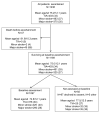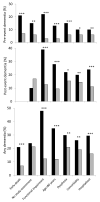Methodological factors in determining rates of dementia in transient ischemic attack and stroke: (I) impact of baseline selection bias
- PMID: 25657179
- PMCID: PMC4342416
- DOI: 10.1161/STROKEAHA.114.008043
Methodological factors in determining rates of dementia in transient ischemic attack and stroke: (I) impact of baseline selection bias
Abstract
Background and purpose: Many previous studies on dementia in stroke have restrictive inclusion criteria, which may result in underestimation of dementia rates. We undertook a large prospective population-based study of all transient ischemic attack and stroke to determine the impact of study entry criteria on measured rates of pre- and postevent dementia.
Methods: All patients with acute transient ischemic attack or stroke from a defined population of 92 728 are referred from primary care or at hospital admission to the Oxford Vascular Study (2002-2007) and have baseline clinical and cognitive assessment and follow-up. We examined the impact of early death, other nonavailability, and commonly used selection criteria, on measured rates of dementia.
Results: Among 1236 patients (mean age/SD 75.2/12.1 years, 582 men, 403 transient ischemic attack), 139 died or were otherwise unavailable for baseline assessment, 319 had prior dependency, 425 had comorbidity, 512 were aged ≥80 years, 85 were dysphasic, and 502 were hospitalized. Pre-event dementia was 3-fold higher in patients dying preascertainment (10/47, 21%) and twice as high in other nonassessed (14/92, 15%) versus assessed patients (69/1097, 6%; P=0.0006 and P=0.002) and was several-fold higher in those with prior functional impairment (24% versus 3%; P<0.0001), age >80 years (13% versus 3%; P<0.0001), dysphasia (11% versus 7%; P<0.0001), and comorbidity (10% versus 6%; P=0.04). Findings for postevent dementia were similar: prior functional impairment (40% versus 13%; P<0.0001), age >80 years (28% versus 10%; P<0.0001), dysphasia (39% versus 15%; P<0.0001), and comorbidity (20% versus 15%; P=0.04).
Conclusions: Exclusion of patients unavailable for assessment, and other widely used selection criteria, results in underestimation of the measured rate of dementia associated with transient ischemic attack and stroke.
Keywords: dementia; ischemic attack, transient; selection bias; stroke.
© 2015 American Heart Association, Inc.
Figures


References
-
- Pendlebury ST, Rothwell PM. Prevalence, incidence, and factors associated with pre-stroke and post-stroke dementia: A systematic review and meta-analysis. Lancet Neurol. 2009;8:1006–1018. - PubMed
-
- Pendlebury ST. Dementia in patients hospitalized with stroke: rates, time course, and clinico-pathologic factors. Int J Stroke. 2012;7:570–81. - PubMed
-
- Rothwell PM, Coull AJ, Giles MF, Howard SC, Silver LE, Bull LM, et al. Oxford Vascular Study Change in stroke incidence, mortality, case-fatality, severity, and risk factors in Oxfordshire, UK from 1981 to 2004 (Oxford Vascular Study) Lancet. 2004;363:1925–33. - PubMed
-
- Rothwell PM, Coull AJ, Silver LE, Fairhead JF, Giles MF, Lovelock CE, et al. Oxford Vascular Study Population-based study of event-rate, incidence, case fatality, and mortality for all acute vascular events in all arterial territories (Oxford Vascular Study) Lancet. 2005;366:1773–83. - PubMed
Publication types
MeSH terms
Grants and funding
LinkOut - more resources
Full Text Sources
Medical

